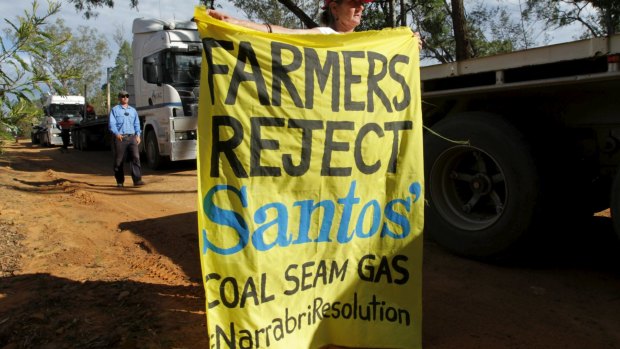Three and a half years ago then NSW deputy premier Andrew Stoner announced a memorandum of understanding with energy company Santos to "fast track" development of its Narrabri gas project in the Pilliga Forest.
With the issue of a looming gas shortage gaining momentum, Stoner noted the project's "capacity to directly supply up to 25 to 50 per cent of the State's natural gas needs".
Then-energy minister Anthony Roberts said the project "has the potential to play an important role in reducing the impact of energy prices on the cost of living in NSW".
Stoner added that an approval by 2015 would mean the gas could start flowing by 2017.

The Santos Narrabri CSG project has prompted protests.Credit: Dean Sewell
But difficulties encountered by Santos in the intervening period meant it was in March this year that the company formally applied to develop the area.
Prime Minister Malcolm Turnbull might be now urging NSW to approve the project, but this missed a couple of key points.
The first is that the NSW government is committed to putting any such project through the independent Planning Assessment Commission, so it can't simply tick it off.
The second is that even if it was to be approved by, say, the end of this year Stoner's timetable suggests it would be at least two years before gas starts flowing.
Meanwhile, the prime minister's complaint that NSW and Victoria "are not doing enough" conveniently ignores the difficult history of gas exploration in this state.
The prospect of drilling under homes in south west Sydney prompted then premier Barry O'Farrell in 2013 to announce a two-kilometre buffer zone for coal seam gas exploration around any residential area.
The spectre of drilling on the fertile Liverpool Plains and on other prime agricultural land saw introduction of CSG exclusion zones around horse breeding and wine producing areas deemed to be "critical industry clusters".
The prospect of losing Nationals held seats on the NSW north coast has delivered the North Coast Regional Plan 2036 which states the government "has no intention to revive coal seam gas on the North Coast."
Just how real this threat is was illustrated at the 2015 election when the Greens took the seat of Ballina from the Nationals and came within a whisker of doing the same in Lismore.
It is also evident in the way NSW Energy Minister Don Harwin recently announced the government's first tentative steps towards restarting the NSW gas industry, having bought back $27 million worth of licences issued by Labor.
The first new potential exploration areas will be in the relatively politically palatable region of far western NSW.
Turnbull will be well aware of all of this, but with the opposition on the attack over energy prices he needs a scapegoat to blame for his own political mess.
Bashing the states is the oldest trick in the federal playbook. It might provide the prime minister with a temporary "look over there" moment but is unlikely to achieve much else.